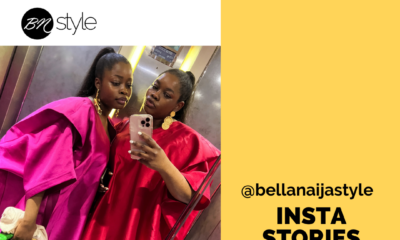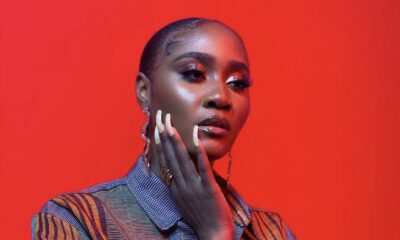Career
Fashion Business Basics with Isoken: 6 Vital Things Every Budding Fashion Entrepreneur Should Know
 Fashion Business Basics is a 6-part series by fashion entrepreneur with Isoken Ogiemwonyi, which will feature on BellaNaija. You may recall BN featured Isoken and her partner in the BN Making It series, back in 2011. Since then, she has gone on to achieve even greater feats, making her mark firmly in the fashion industry in Nigeria. We hope that aspiring fashion entrepreneurs will benefit from this series.
Fashion Business Basics is a 6-part series by fashion entrepreneur with Isoken Ogiemwonyi, which will feature on BellaNaija. You may recall BN featured Isoken and her partner in the BN Making It series, back in 2011. Since then, she has gone on to achieve even greater feats, making her mark firmly in the fashion industry in Nigeria. We hope that aspiring fashion entrepreneurs will benefit from this series.
****
Not all entrepreneurs succeed, and often it takes more than a few tries to create a successful business. With the current economic downturn, there is clearly an opportunity for both domestic and international consumption of Nigerian fashion. All of this whilst battling the increased cost of inputs (pretty much everything, from textiles to machinery, is imported).
A weaker Naira, undeniably, makes non-oil exports a very attractive proposition. What does this mean for you, a budding fashion entrepreneur? Luckily, technology has made it far easier to figure out what works and what doesn’t. It also enables us triturate far quicker than would have been possible in the past. For example, with a few quick swipes on your smartphone, Instagram – undeniably one of the strongest drivers of discovery for visual content in general and fashion on particular, in practice gives you a global storefront. Even a few hundred followers, can make a huge difference to your bottomline. The only drawback is that we are spoilt for choice and cutting through the noise is a gargantuan task.
Think of this as a back to basics primer for the African fashpreneur in 2016:
Remember, fashion is ultimately a business
Every activity we undertake, from marketing to retail has one goal – to sell. Unfortunately with all the hype around fashion and the ‘glamour’of the industry, brands often forget this. To build a successful and economically viable brand, it is important to think like an entrepreneur right from the beginning. You must understand how a business works, and what factors affect your business in particular.
For example, a primarily ready-to-wear designer has a different cost and revenue structure from an aso ebi designer’s own – that focuses equally on both. It means putting together a plan that lays out short, medium and long term scenarios and where possible, step by step How To’s of achieving these plans. The next most important ingredient once your company is up and running, is building solid relationships with retailers, press, investors and organising your manufacturing or atelier. This helps you to be consistent and reliable. No one likes a one-hit wonder. Even if you have the most amazing, creative and visually stimulating cookbook, the product must match the hype.
You also have to WANT to succeed as a business – more than anything else. The determination to give it your very best differentiates the best fashpreneurs from the hobbyists and glory hunters.
Product and product development is everything
It may sound cliche – but start small. A single product line that is consistent, cohesive and representative of your brand DNA is more likely to be successful, and gives the brand a point to grow from. A stellar example of that is Mansur Gabriel – a brand (almost) single handedly responsible for the return of the ‘It’ bag.
They took the fashion world by storm with their exquisitely executed bags in a few colour ways. They have gone on to build on their initial product line, to include shoes and new handbag styles and they still sell out season after season. Lest I forget – price is a crucial factor in finding success as a brand – even more so in the developing world where our pockets are not as deep.
Work it out by starting with the amount that a customer would be realistically willing to pay, and working backwards to calculate how much you can spend on materials and manufacturing while still turning a profit.
Adjust, adjust and adjust again to reflect a reasonable RRP. There’s no point in creating and manufacturing a costly product that no one will buy. Or even more irksome – a substandard product with an eyewatering price. It’s not about what you ‘think’ your brand or design talent is worth – the market dictates what will work and what won’t.
Finally, pay more attention to buyer feedback, both at retail and at the individual level, than press. Great reviews are just that, great – and may lead to exposure and new buyers – but press cannot sustain your business, sales will.
Know your brand and communicate it well
Your brand identity should be defined right at the beginning. Your unique point of view is the ‘why’ of the buy. Why should a consumer buy you and not another brand? Create a marketing plan that sets out who you’re targeting and what your approach will be.
Where is your customer? Is she more likely to discover you on a visual social media tool like Instagram than a glossy magazine? Hiring a PR company may be a good idea – but only if you can afford it at this stage in your business.
Communication is important and there must be a strategy for it and the means to execute it season after season. It must be clear, cohesive and consistent, but fresh every season. You must learn to interpret your brand in a way that is relevant toboth you and the zeitgeist. (Sounds exhausting I know!)
The production challenge
This is arguably the bane of almost every designer on this continent, but it is a major key to your success regardless. You can start small with your own atelier, or decide to pool resources with other designers; whatever you do, there must be a plan. A ready-to-wear designer should be thinking in terms of quantities per style per size; aso ebi’ designers should think of what level of bespoke business they need to sustain their business and achieve their goals on a weekly, monthly or yearly basis.
Sales and distribution – the key to success
We have come a long way in terms of retail opportunities for both consumers and designers. The ecosystem doesn’t support a lot of wholesale buying but it does exist. There are also opportunities for licensing and more curated opportunities designed to give new brands a bullet payment for a limited production run and exclusivity. The more well structured your business is, the more likely a retailer isto bet on your brand with their wholesale budget. You need to think about your brand in a retailers context. How do you compare to the competition? Who is going to buy the product? Where you would like to be sold, realistically?
Will it be the right price? These questions have to be answered before picking up a pen to design, or at the very worst used to critically assess your collection. If you’re planning to sell online, be aware that colourful and printed products are usually most popular; any garment with an unusual shape or fit is going to be a tough sell on a website. You’ll also need a complete range of sizes. Once you can afford it, setting up your own website will max-imize your profit margins and give you direct access to customers. If you’re setting up your own store you need to think about running costs and overheads such as rent, diesel, generators, staff etc.
You also need to figure out how to drive a reasonable amount of retail traffic to make your business profitable. For a made-to-order business, you need to have a tight hold on your supply chain particularly the pipeline for converting leads to paying customers. How do your clients discover your brand? How do you keep a basic level (and this has to be determined based on your minimum order rate vis a vis the survival of your business) of repeat custom? What do you need to gain new custom?
Understand the importance of cashflow, funding and financing
Cash is king – not because you have lots of it in the bank, sitting there looking pretty – but because without it, your business will drown.
Bearing in mind that in this environment, credit terms are at best sparse, and at worst non-existent. Fashion is notoriously capital intensive. Cash flows out wards, for developing the line and production, way before it makes its way back from wholesalers, retailers or customers. Keeping your finances under control and your head above water is your most critical task as an entrepreneur. Investment is a limited option for most; but for those that it is, it is losing a little control (the assumption here is that it’s a fair deal)
Always, remember that a 100% of zero is, well zero and 1% of $2bn is worth far more to you.
Case in point – Eduardo Saverin, one of the co-founders of Facebook, owns approximately 0.4% of all outstanding shares and has a net worth of $7.2 billion, Now wouldn’t you rather be Eduardo?
Photo Credit: Emmanuel O.

























